The Economics and Statistics Division maintains archives of previous publications for accountability purposes, but makes no updates to keep these documents current with the latest data revisions from Statistics Canada. As a result, information in older documents may not be accurate. Please exercise caution when referring to older documents. For the latest information and historical data, please contact the individual listed to the right.
<--- Return to Archive
For additional information relating to this article, please contact:
January 22, 2020WHOLESALE TRADE, NOVEMBER 2019 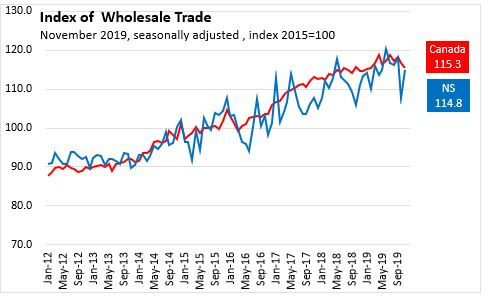
The month-over-month index of wholesale trade illustrates the volatility of Nova Scotia seasonally adjusted wholesale trade in comparison to the national index. Year-to-date comparisons are more indicative of economic conditions for such volatile indicators.
In Nova Scotia November 2019, on a seasonally adjusted basis
- month-over-month Wholesale Trade increased 6.7 per cent to $880.2 million over October 2019.
- year-over-year Wholesale Trade increased 3.4 per cent over November 2018.
- year-to-date (Jan-Nov 2019) Wholesale Trade increased 3.2 per cent over Jan-Nov 2018.
In Canada November 2019, on a seasonally adjusted basis
- month-over-month Wholesale Trade decreased 1.2 per cent to $63.2 billion over October 2019.
- year-over-year Wholesale Trade increased 0.6 per cent over November 2018.
- year-to-date (Jan-Nov 2019) Wholesale Trade increased 2.3 per cent over Jan-Nov 2018.
BY PROVINCE
On a month over month basis, seasonally adjusted Wholesale Trade was down 1.2 per cent nationally. Four provinces reported monthly increases in wholesale trade, with Nova Scotia (6.7 per cent) reporting the largest gain in percentage terms. Saskatchewan reported the largest decline (4.7 per cent) over the previous month.

On a year-over-year basis, seasonally adjusted Wholesale Trade was up 0.6 per cent nationally. Seven provinces reported year-over-year increases in wholesale trade, with Prince Edward Island (16.3 per cent) reporting the largest gain in percentage terms. Nova Scotia reported an increase (3.4 per cent) over the previous year. Compared to November 2018 Saskatchewan reported the largest decline (12.9 per cent).
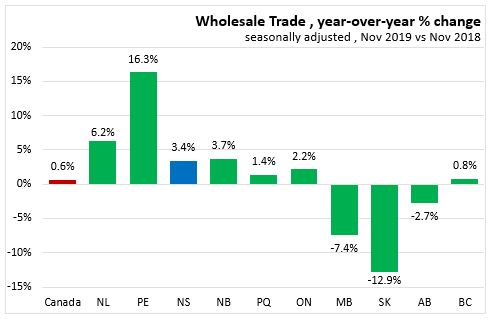
Year-to-Date (Jan-Nov 2018 to Jan-Nov 2019)
On a year-to-date basis, in Canada seasonally adjusted Wholesale Trade was up 2.3 per cent. Seven provinces reported year-to-date increases in wholesale trade, with Prince Edward Island (15.8 per cent) reporting the largest gain in percentage terms. Nova Scotia reported an increase (3.2 per cent) over the same period last year. Compared to Jan-Nov 2018, British Columbia reported the largest decline (1.9 per cent).
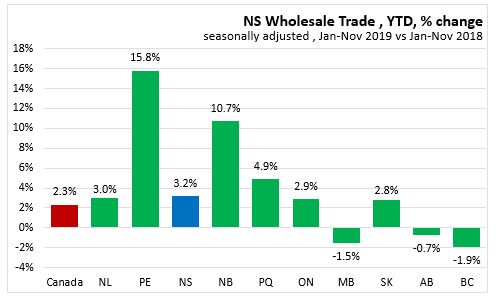
NOVA SCOTIA SECTORS
Statistics Canada now releases seasonally adjusted wholesale trade data by sector at the provincial level. As there has been significant volatility in recent wholesale values for Nova Scotia, Year-to-date comparisons are more indicative of economic conditions for volatile indicators and seasonally adjusted wholesale values will also smooth out the indicator.
In Nova Scotia (Jan-Nov 2019), Total wholesale trade year-to-date increased 3.2 per cent ($296.1 million) over the same period last year.
In the following sectors wholesale trade increased
- Food, beverage with a 33% share of Wholesale Trade increased 0.6 per cent ($18.3 million).
- Motor vehicle and parts with a 18% share increased 8.5 per cent ($134.0 million).
- Building material with a 19% share increased 1.7 per cent ($31.3 million).
- Machinery, equipment with a 17% share increased 8.0 per cent ($121.4 million).
- Other wholesalers with a 6% share increased 5.9 per cent ($33.0 million)
In the following sectors wholesale trade decreased
- Miscellaneous wholesalers with a 7% share decreased 5.9 per cent ($41.9 million).
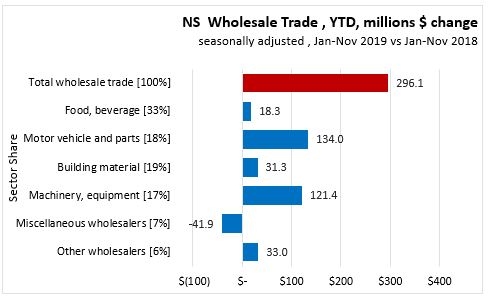
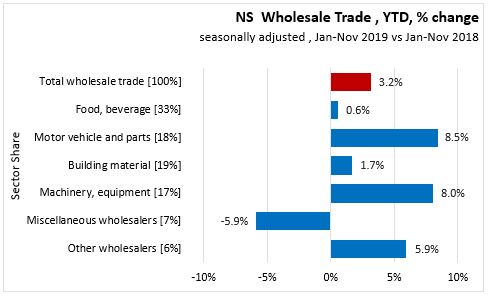
STATISTICS CANADA QUOTES

"Wholesale inventories increased 0.4% to $91.9 billion in November after three consecutive monthly declines. Despite the increase in November, inventories were down 1.8% from their highest level in July 2019.The inventory-to-sales ratio increased from 1.43 in October to 1.45 in November, a level last seen in June 2019.”
“The inventory-to-sales ratio is a measure of the time (in months) required to exhaust inventories if sales were to remain at their current level.”
"Sales in Nova Scotia increased 6.7% to $880 million, the second gain in five months, on the strength of higher sales in the food, beverage and tobacco (+20.8%) and the machinery, equipment and supplies (+6.0%) subsectors."
Reference Tables
20-10-0074-01 Seasonally adjusted Wholesale sales by province
20-10-0074-01 Nova Scotia seasonally adjusted Wholesale trade by NAICS sectors
20-10-0076-01 Canada seasonally adjusted Wholesale Trade Inventory
Citations
Statistics Canada. Table 20-10-0074-01 Wholesale trade, sales (x 1,000)
Statistics Canada. Table 20-10-0076-01 Wholesale Trade Inventories (x 1,000)
<--- Return to Archive